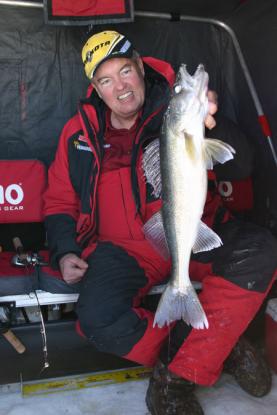 By January; ice fishing opportunities really open up and there’s usually no place for walleyes to hide. With colder temps and the arrival of safe ice you can typically get to every conceivable spot. The bad news is there are too many potential hot spots and it might take some leg work and a good deal of elbow grease to find the mother-load. However; when you do uncover their whereabouts you could be set for the rest of the month and even into February because mid season patterns tend to be predictable and relatively consistent.
By January; ice fishing opportunities really open up and there’s usually no place for walleyes to hide. With colder temps and the arrival of safe ice you can typically get to every conceivable spot. The bad news is there are too many potential hot spots and it might take some leg work and a good deal of elbow grease to find the mother-load. However; when you do uncover their whereabouts you could be set for the rest of the month and even into February because mid season patterns tend to be predictable and relatively consistent.
By now the hot early season will have come and gone and it’s time to start looking a little deeper for hungry ‘eyes. Deeper humps, breaks, or even transition zones from hard bottom to soft are likely mid season hangouts. A good place to start looking is where they last made an appearance. That means deeper water close to shallow rocky reefs, weed beds, and shoreline breaks. The idea is to try and think ahead and look for their next step, where they might head to next. In fact there’s probably plenty of fish holding on deeper structure early on in the season, it’s just that you can’t get to them.
Investigating a potential hot spot takes a little time and a high def fish finder like my Humminbird Ice 55/385ci combo. This deadly combination pulls double duty with a high def flasher on one side and a G.P.S. with electronic mapping on the other. The new combo is slick and has a quick release bracket that will allow you to easily move it from your truck to an ATV or sled, or back to the flasher. The 385 can also display compatible Lakemaster maps which are loaded with lakes that have been re-surveyed (big and small), enough so that you will never ever run out of potential hot spots.
 The other piece of the location puzzle includes a jigging spoon like the Northland Tackle Buck-Shot Rattle Spoon tipped with a small minnow or minnow head. Buck-Shots in the 1/16 to ¼ oz range are the big ticket and excellent producers and even better finders. By working what could arguably be called the “hottest ice fishing spoon ever made” under the fish finder you can quickly get an idea if you’re in the right neighborhood because walleyes will at least show themselves, even if they’re not all that interested at the moment. Good jigging rods include those with stiffer actions like Northland’s TSCC-28M loaded with 8lb test Bionic Ice Line which can help you to actually pop and flash the lure up, instead of a simple pull. If you’re seeing fish but not getting any takers it might be a timing issue and you may have to wait them out or come back later.
The other piece of the location puzzle includes a jigging spoon like the Northland Tackle Buck-Shot Rattle Spoon tipped with a small minnow or minnow head. Buck-Shots in the 1/16 to ¼ oz range are the big ticket and excellent producers and even better finders. By working what could arguably be called the “hottest ice fishing spoon ever made” under the fish finder you can quickly get an idea if you’re in the right neighborhood because walleyes will at least show themselves, even if they’re not all that interested at the moment. Good jigging rods include those with stiffer actions like Northland’s TSCC-28M loaded with 8lb test Bionic Ice Line which can help you to actually pop and flash the lure up, instead of a simple pull. If you’re seeing fish but not getting any takers it might be a timing issue and you may have to wait them out or come back later.
During the day I’d at least expect to see some fish if I’m in the right vicinity, and would probably cross the area off of my prime time list if nothing is happening. And if I’m seeing fish in deeper water; I’d still work the shallower edges of deeper structure when the sun is going down. Active fish typically move shallower when they turn on and if you stay deep during peak periods you might miss out on the hottest action. Deeper water can make for good daytime activity but the shallow move will probably still occur late in the day, even on darker bodies of water like Leech and Lake of the Woods. And don’t let tiny fish fool you into thinking you’re right where you need to be. A pod of small fish can look like a big one, although the Ice55 with its narrow beam mode and zoom does an excellent job of breaking out fish into individual signals.
Personally; I love the mid season because you can usually catch at least a few fish all day, unlike first ice where you have to get out super early or stay too late if you want any chance at all of hooking into old marble eyes. See you on the ice.










